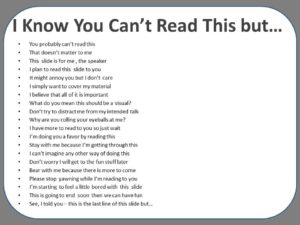Three Most Common Mistakes with a PowerPoint Presentation
You’ve probably endured too many painful presentations – most of them dominated by PowerPoint slides. Have you wondered why so many presenters still deliver painful PowerPoint presentations?
Why are the presenters reading the slides to you? Do they believe you can’t read? Why did they put so much text on the slide? Why is the slide so cluttered and confusing? Why are they using slides that add little or nothing to the message? Why are presenters ignoring the audience experience?
What are the mistakes of a painful PowerPoint presentation?
The first mistake is a mindset error. The speaker refers to the slide deck as “the presentation”. If you believe the slides are “the presentation” why are you there? We don’t need you. Just send the slides and you can stay home.
Instead, reset the mindset. You are the presentation. The slides are there to augment your message – to illustrate or reinforce your message.
We buy you – not your slides. Don’t lean on your slides. Don’t hide behind your slides.
The second mistake is to write your presentation in PowerPoint.
What’s wrong with that? It stifles your creativity. It forces you into a confined mode of thinking only within PowerPoint slides. What does that usually look like? Often that’s bullet point lists and too much text on the slide.
Maybe you throw in a weak or unrelated image and feel good about yourself. You feel good about yourself, but that image doesn’t reinforce the intended message.
You don’t care because you need the text to remind you of your message.
What would be better?
Write your presentation outside of PowerPoint. Best on paper – maybe on a note pad, flipchart or even a white board. That enables you to free-form ideate and explore options about how best to convey your message.
Don’t write your presentation in PowerPoint.
The third mistake is to design your slides to be the handout.
This is a highly destructive mistake because your slides and your handouts serve two distinct purposes that are best delivered in different mediums.
The best use of slides is to present visuals. That means images, sketches, maps, charts and cartoons. Images! Text is NOT a visual. Think television especially for virtual presentations.
Handouts are the vehicle to provide more information usually in text with some visuals. Handouts should look like a newspaper or magazine. Your slides should look more like a billboard or television.
Your slides should never be the handout. Slides are meant to be viewed on the screen.
Your handouts are documents to be printed, reviewed and studied.
PS: Stop calling them handouts – instead refer to these documents as supplementary resources. “Handouts” sounds so cheap.
Avoid these common PowerPoint presentation mistakes and you are on the way to a more effective and enjoyable presentation. Your audience will thank you.
Arrange Presentation Skills training for your team
http://superiorpresentations.net/
Connect with George Torok on Linkedin
https://www.linkedin.com/in/georgetorokpresentations/
Listen to the podcast – Your Intended Message with host. George Torok
https://yourintendedmessage.podbean.com/
Related posts for you
Public Speaking for Executives
Create and Deliver your Presentation on Purpose
What are the Three Communication Channels to the Brain?


